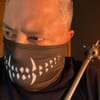The Fantastic Four: First Steps
It's clobberin' time.
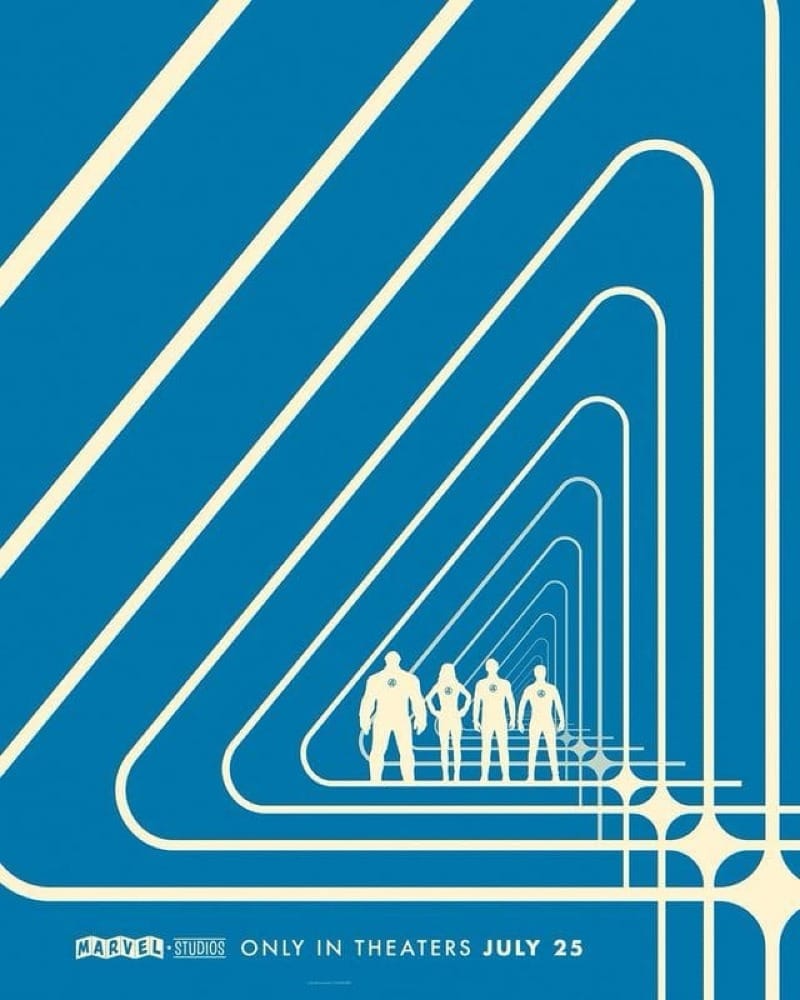
Mister Fantastic, the Invisible Woman, the Human Torch, and the Thing must defend the Earth from total annihilation after the Silver Surfer appears out of the darkness of space, and announces the imminent arrival of Galactus, the Devourer of Worlds.
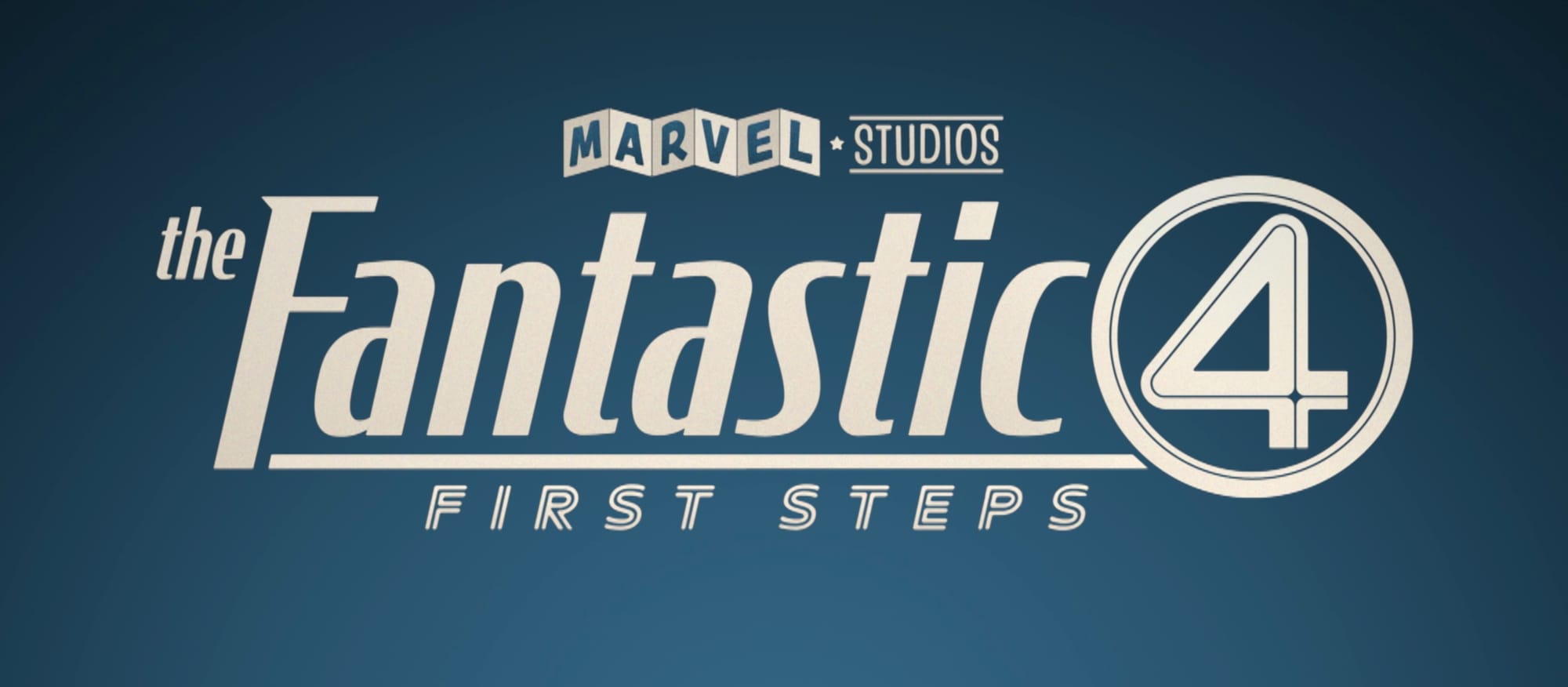
The first choice this film made that I loved is how, much like with Superman, the 37th MCU movie assumes that you already know the basics of the Fantastic Four's origin (and if you don’t, there's a nice summary), and otherwise doesn't spend the entire movie recounting a tale that has already been told more than enough times.
Personally, I really appreciate the en media res approach.
For one, like I said, there's no need to retrod oft-walked ground. Two, in the seventeen years since Iron Man was first released, the MCU has made somewhere around 32 billion dollars at the box office. So it's fair to say that superheroes now occupy a familiar place in pop culture, and that audiences are now familiar with its common tropes and trappings. This reality means that superhero origin stories are now a lot like prequels... they're basically guaranteed to be narratively inert. Not always, sure, but pretty much. Simple fact, it's a difficult task trying to overcome the predestination inherent within these tales, and that's because they always go the same way. Guess what... they get their powers, they realize their mission, vow to fight for justice, beat the initial bad guy, and then the film usually ends with a brief glimpse of the characters putting on their cool outfit for the first time.
It's so boring.
It's much better to just assume that everyone is on the same page, and to start things off in the middle of the action, rather than at the chronological beginning. Babying audiences, spoon-feeding them information, leading them slowly down a familiar path, this is why most audiences are stupid. When it comes to these kinds of brightly colored "fisticuffs and quips" sci-fi/fantasy movies, they're just not that complex, or difficult to follow. They're silly kids' movies. And that's the best part about these en media res beginnings... it expects viewers to understand the world they are being shown, to understand the story they are being told, to know who the characters are... simply by paying attention.
That's it. Watch the movie.
It's a seemingly extreme idea, I know, but yeah... try actually watching the film, instead of... y'know... idlly scrolling on your phone, or chatting in an outside voice with your friend, or changing a crying baby that you shouldn't have brought to a movie theatre in the first place, or ignoring your pack of filthy and wildly over-sugared children who aren't capable of sitting still, or recording a TikTok that no one will watch because you're not actually an influencer by any measure at all, or maybe masturbating into a black sock, or perhaps quietly pooping in a semi-lit back corner of the theatre, or vomitting in your popcorn bucket and leaving it next to your seat, only to kick it over when you leave, or forgetting your shoes behind, because you're a filthy fucking pig who walks around barefoot on a floor that people regularly shit, jizz, puke, piss, and/or spill sugary substances on THAT HAS NEVER ONCE BEEN CLEANED... or whatever it is you do, that years and years of both going to, and working at, multiple movie theatres has taught me that way too many people prefer to do, instead of just watching the film they specifically chose to see, when asked by the box office person, and then bought a ticket for using actual real money.
But I digress...
The second choice that this film made that I loved, was the decision to set it in a classic Stan Lee/Jack Kirby-era inspired and very stylized 1960s futurism world, all to tell a story that draws its elements directly from Lee and Kirby's original run. Not only does it look great, but these stories changed Marvel forever, they changed superhero comics forever, in fact. The Fantastic Four used classic sci-fi pulp ideas and tropes, like exotic locales, hidden cities, deep space, ancient mysteries, super science, alien invaders, time travel, giant monsters, and supervillains in exciting tales of derring-do, that then featured a "realistic" family unit that squabbles and fights, but who are ultimately bonded by more than just the unusual circumstances that gave them their powers, and at the time, that was a revolutionary concept. And as a result, it quickly became the biggest hit of the early Silver Age of comic books (around 1956 to around 1970). So, this was the perfect aesthetic choice to introduce the Fantastic Four to the wider world.
Plus, like I said, it looks great.
The characters deserve the love and consideration too. Even during the 90s and early aughts, when the title was a bit out of fashion, The Fantastic Four have long been a "Big Show" kind of title in the world of superhero comics. Working on The Fantastic Four book is a high-visibility job, the kind where you either make your bones as a creator, or tumble into ignominy. Because, much like Superman, the Fantastic Four have a long and daunting legacy of quality and standing, but due to the perceived innocence/goodness/naivety of the title, and its deceptively simple subject matter of a family of explorers and adventurers, it is considered by many to be a difficult thing to write well. Of course, most of the people who say this shit out loud are the kinds of creators and fans who really only feel at home with the more entry level, easy to understand characterizations and motivations of characters like Punisher or Batman, but still... this is the widely held belief.
And because of that, when a comic creator is looking to make their mark, this is one of the titles that they most want to take for a run. And no one has done a better job with Fantastic Four in the modern era of comics than Jonathan Hickman and Dale Eaglesham. Their run was the best the book has been since the Lee/Kirby era. Not only did the nail the heart of each character, and their relationships as a team and a family, but the central story line they built ultimately affected the entire line of Marvel comic titles. It shook the very pillars of Heaven, as they say. So it's good news for us then that this era is also one of the other main places this film pulls its story elements from. In a nutshell, what I'm saying here is that this film is drawing its inspiration from the best possible versions of the comics.
And that means, I'm very excited to see it.
Also, finally, before we get into it... just so we’re clear, comparisons to the Incredibles are fine and inevitable, but that’s because, as good as the Incredibles is, it’s really nothing more than Fantastic Four fanfic. The Incredibles simply do not exist without the Fantastic Four. On top of that, as the setting and look of this film will show, The Fantastic Four is also one of the many inspirational roots of The Ventures Bros tv show. I tell you this, because at some point, you're probably going to hear some stupid hipster sniff with disdain, and say that they liked this film better when it was the called The Venture Bros, and I want you to know for certain, without exception, that if you do hear some wad-job fuckhead in "vintage" clothing say some shit like this, that they are a poser and a pretender, and deserve nothing but derision... and maybe a good swift kick in the ass too.
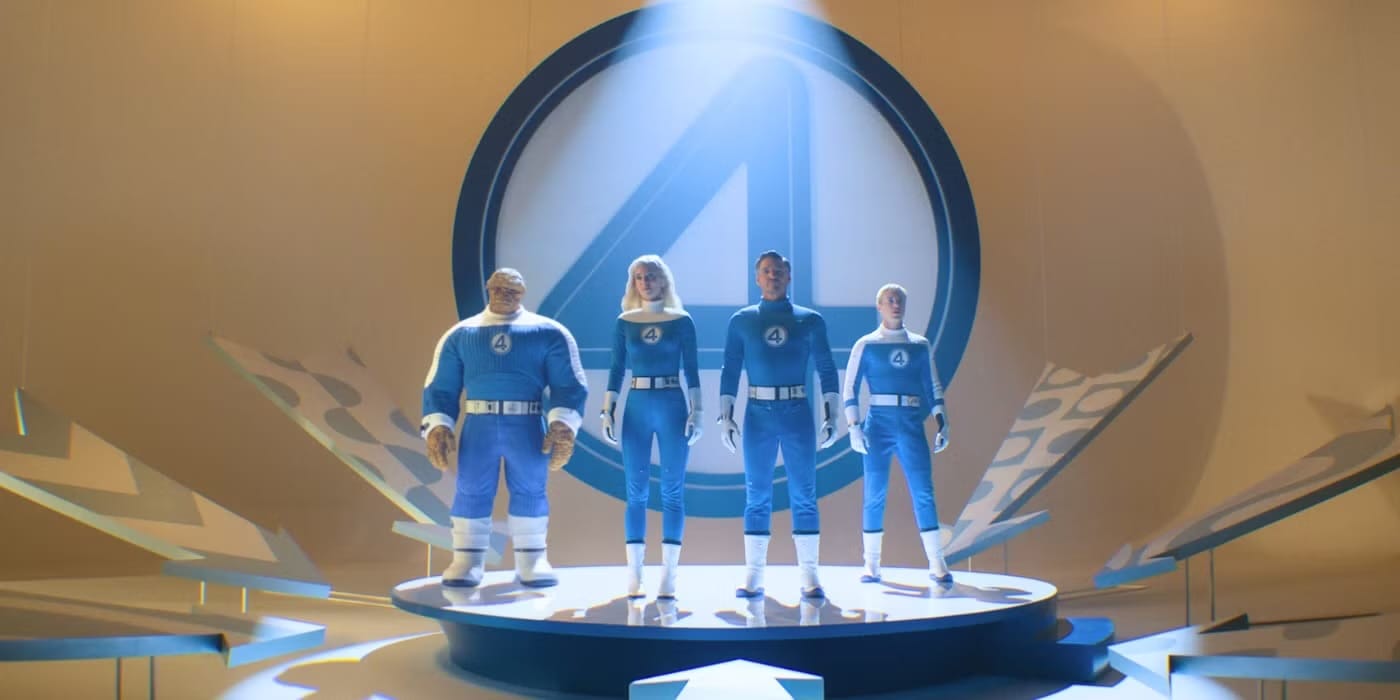
Anyway...
The Characters
The Fantastic Four
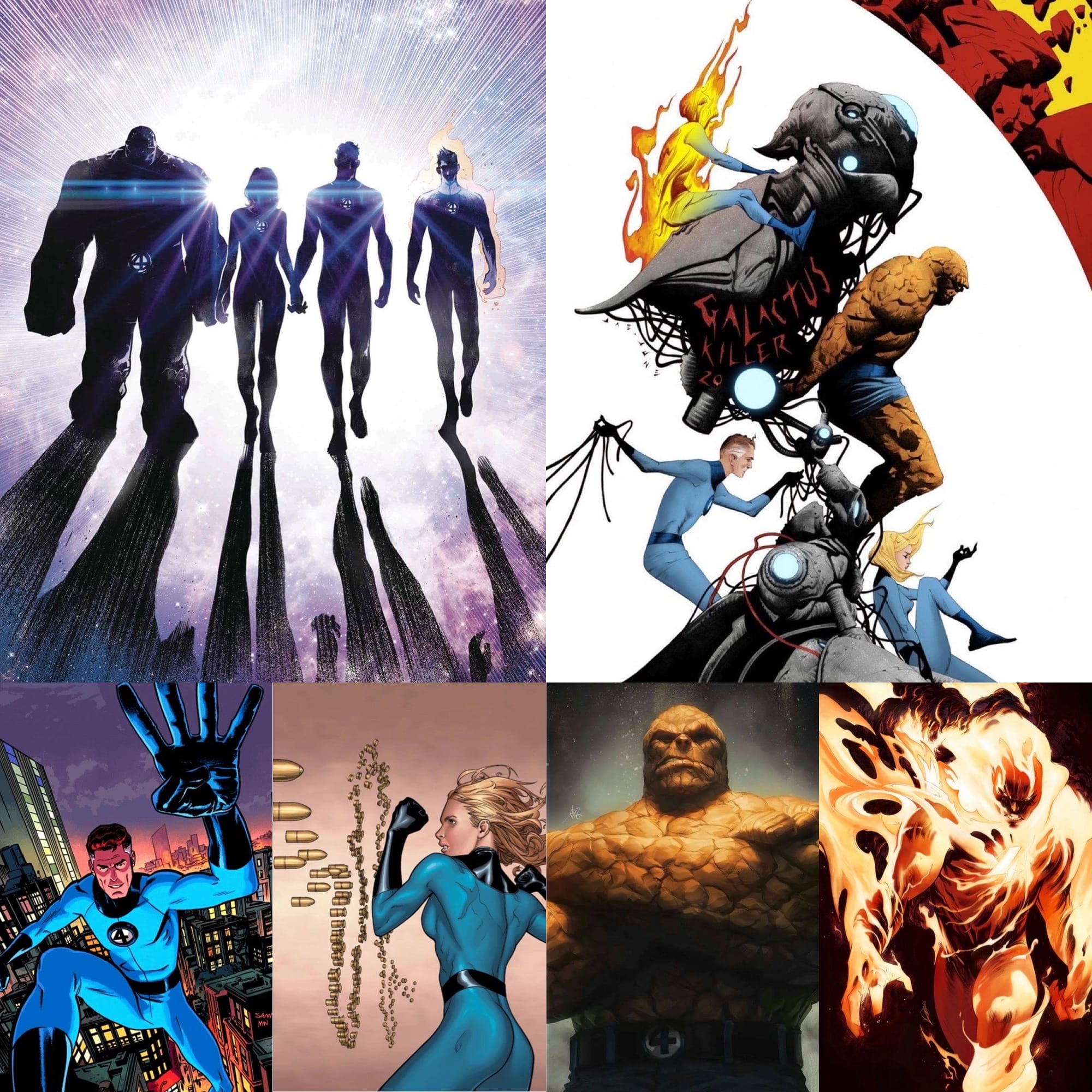
The Fantastic Four, or the FF, is a superhero team created by Stan Lee and Jack Kirby, that debuted in The Fantastic Four #1 of November 1961. It was the pair’s first superhero collaboration, and the origin of the comic book production style that came to be known as the “Marvel method.” This is where Stan Lee would come up with a plot, then Jack Kirby would sketch the events and characters out based on Stan Lee’s synopsis, and also adds some of his own ideas, and finally, then Stan would write the dialogue. It’s an absolutely insane way of doing things.
I can’t even imagine.
Much like Superman, the Fantastic Four's origin has stayed basically the same in the sixty-four years since their first appearance.
Brilliant super-scientist Reed Richards designs and builds an experimental faster-than-light rocket. His plan is to use the ship to visit an Earth-like planet located in a star system light years away. Unfortunately, his financial backers get cold feet and pull his funding. With his life’s work in danger of being shut down, Reed, his best friend Ben, his girlfriend Sue, and his girlfriend’s little brother Johnny, break into the facility, steal the rocket, and launch into space anyway. But once in space, the rocket passes through a storm of cosmic radiation, and the rocket’s shielding is unable to withstand the storm’s intensity. The rocket crashes back down to Earth. When they emerge from the wreckage, the four intrepid explorers find that they have been irrevocably changed…
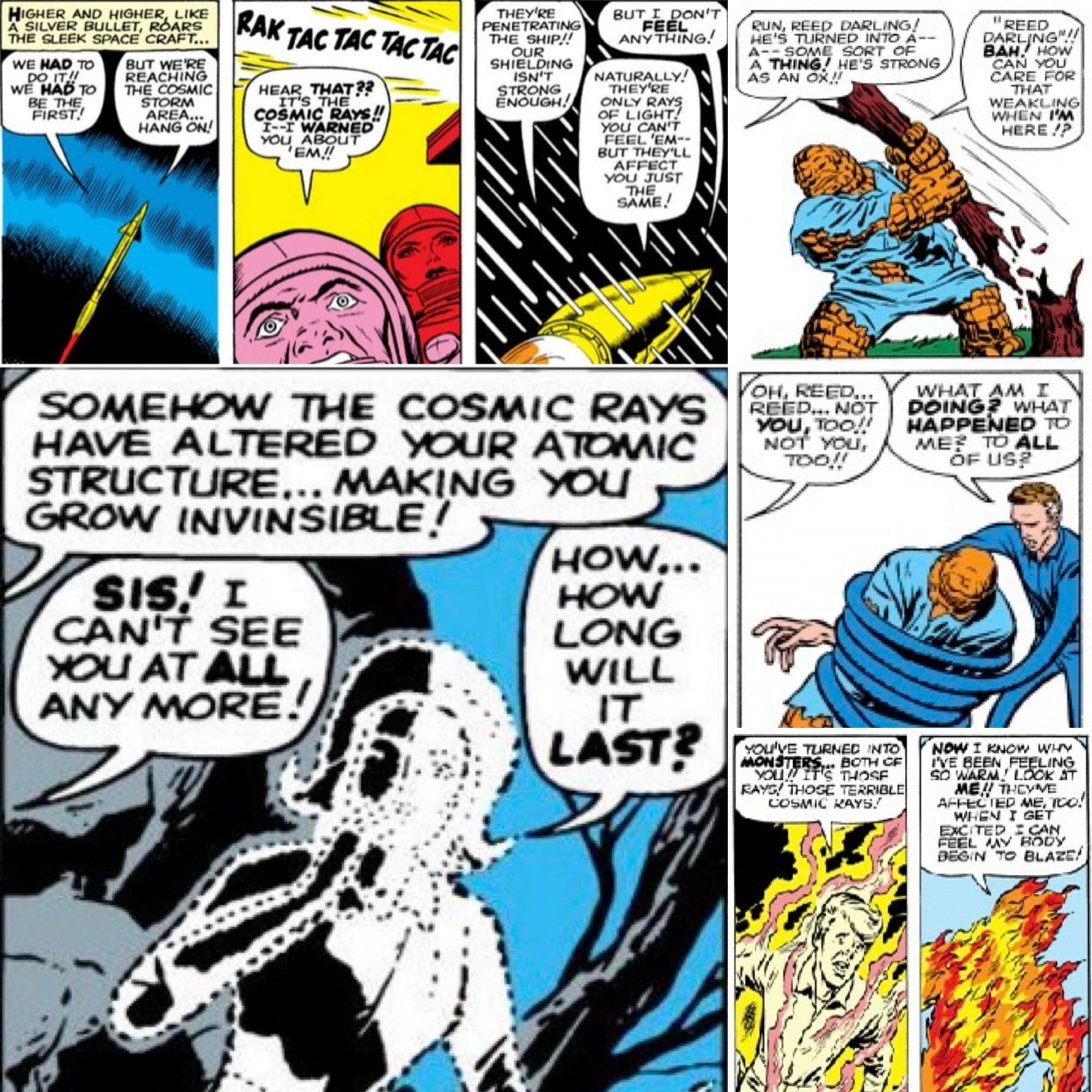
Basically, Reed Richards is a lot like that submarine billionaire dipshit, except his “I know what I’m doing” white guy bullshit ended up giving them all superpowers, instead of getting them all crushed in a tin can. This is the main difference between comics and the real world. If you drink a mystery liquid that you found in a lab in the real world, at best, that's someone's urine, at worse, congratulations, you now have cancer. But in the comic book world, you can now fly, are invunerable, and can punch through a mountain. This means that, once you put on a brightly color-coordinated set of tights and a mask, you are now qualified to police the world as you see fit.
Comic books!
So, anyway, while there’s been several different members, as well as iterations of the team, over the years, the original—and to be honest, the only real version of the team–representing the four elements, The Fantastic Four are…
- Mister Fantastic (Reed Richards) – Reed is a scientific genius, one of the smartest and most clever people alive. Inspired by Plastic Man, Reed can stretch, twist, and re-shape his body to inhuman proportions. He is the leader of the team, as well as the father figure, and is usually portrayed as pragmatic, easily distracted by problems and sudden inspiration, and somewhat overly-literal. He’s Ward Cleaver meets Rick Sanchez meets the Nutty Professor. He still carries the guilt of the havoc his work wrecked on his friends and family, but much like curing cancer, he’s never done anything about it, as he’s long been too concerned with making flying bathtubs, and clothing made out of “unstable" molecules, and portals to places called The Negative Zone, which right away sounds like a place not worth visiting... or is that just the Negative Zone already having an affect on me...?
- Invisible Girl/Invisible Woman (Susan Storm) - In order to avoid making her into the “Wonder Woman“ of the group, and inspired by H.G. Well’s Invisible Man, Sue was given the ability to manipulate light in order to render herself and others invisible, as well as the ability to create force fields she can use both defensively and offensively. She is the "mom" of the FF. Originally just Reed’s girlfriend, and later his wife and the mother of his children, Sue was originally included in the FF’s original mission solely for that reason, just an extra seat on the rocket ship for Reed’s boo, who had a tendency to cry and/or faint a lot, at least, when she wasn't concerned with her hair. That having been said, despite a brief and unfortunate mid-life crisis, Sue has since become a pillar of the Marvel Universe, a leader and a hero, someone the others can look up to and rely on, which is something this film did a really good job of portraying.
- The Human Torch (Johnny Storm) – Loosely based on the original version of The Human Torch—one of Marvel’s original characters, when it was known as Timely Comics, an android who could ignite itself on fire, mostly because Stan Lee didn’t want to waste the cool name and power–Johnny Storm possesses the ability to control fire, which allows him to cover himself in fire, and to project fire from his body, and also the power to fly… while on fire. Johnny Storm was originally just Sue’s kid brother, a hip teen who said things like "daddy-o" and decided to tag along on the rocket with his sister and her boyfriend, because Stan Lee literally did not give a fuck whether or not any of that shit made sense. For a long time, unlike most “gee willickers!” teen sidekicks of the time, Johnny was portrayed as a brash and obnoxious little shit. He eventually outgrew that, and became a cocky “hot-headed” adult. He is the entire group’s irresponsible little brother, and the "Funcle" to Reed and Sue's kids.
- The Thing (Ben Grimm) – A former astronaut, USAF test pilot, and also a decorated combat pilot in WW2 originally, not to mention Reed Richards' best friend and former college roommate, Ben went up in that rocket as a man, and came back down the most visibly changed. He emerged as a monstrous, orange rock-covered humanoid, and while he had superhuman strength and durability, he was stuck this way, unable to turn back to a human. As a result, The Thing has often been portrayed as filled with anger, self-loathing and self-pity over his new existence. A gruff and grumpy working class Brooklyn type with a short temper, he was originally intended as “the heavy” of the group, but he has since evolved into the soft-hearted uncle figure, and an honest and direct presence on the team, one free of pretension. He was well known for smoking cigars until Marvel decided to no longer show smoking. After Spider-man and the Hulk, the Thing has long been one of Marvel’s most recognizable characters.
The whole idea was born after comic book publisher Martin Goodman, upon seeing the success of the Justice League of America comics over at DC Comics, starring The Flash, Wonder Woman, Green Lantern, Aquaman, and the Martian Manhunter, directed his comics editor, Stan Lee, to also create a superhero team comic book. According to Lee, his thought was “just this once, I want to do the kind of story I’d enjoy reading, with characters I can relate to. Flesh and blood, faults and foibles, fallible and feisty, and most importantly, with feet of clay." Years later, Jack Kirby would claim that Stan Lee was, like always, embellishing things, and that the idea for The Fantastic Four was mostly his, pointing to the obvious similarities the FF share with the Challengers of the Unknown, a team of adventurers that Kirby created for DC Comics in the ‘50s.
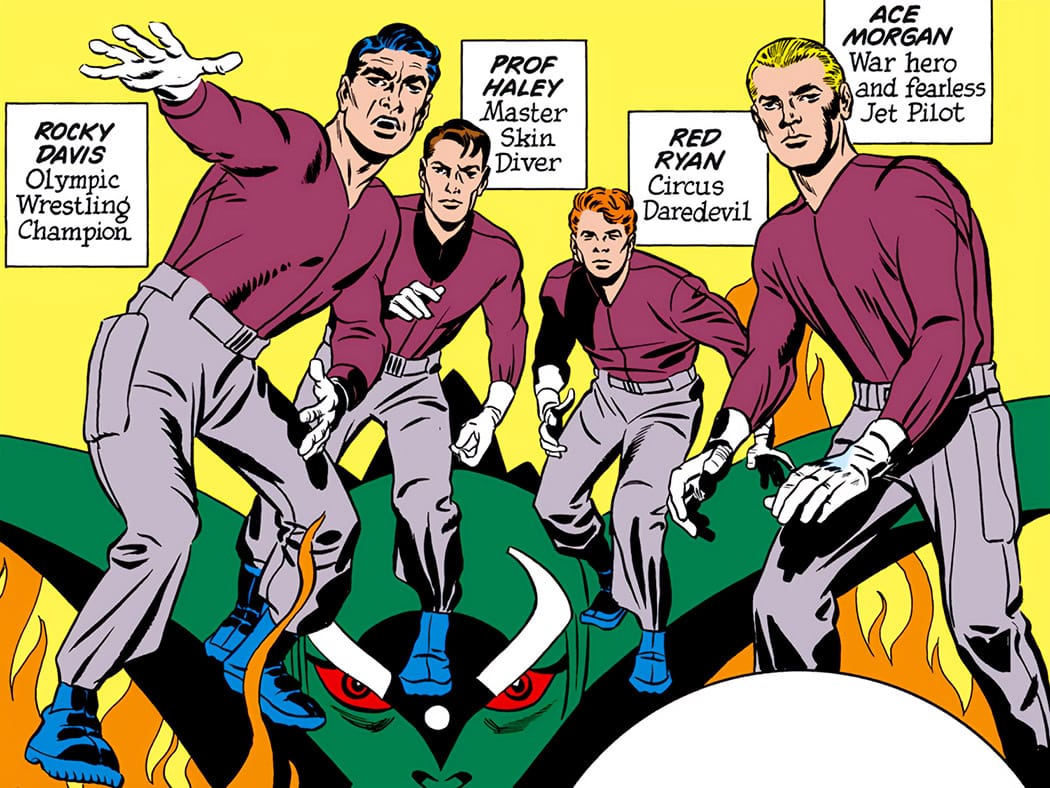
Either way, The Fantastic Four helped usher in a new level of “realism” in comic books, as this superhero team were portrayed as a somewhat dysfunctional, and yet still loving family unit.
That’s basically all they mean when they say "realism."
It sounds silly, but it absolutely shattered the status quo when it came to the adventure/sci-fi/fantasy genre, where the more traditional depictions show the heroes to be noble and infallible and without flaws. This new "feet of clay" idea ended up becoming a hallmark of Marvel comics. Characters might squabble, or sometimes they don’t get along. They can have both good and bad personality traits. They can cry, or be scared, or fail, or lash out without thinking. Many of the characters eschewed the idea of having secret identities too. In essence, this was the main difference between the Big Two, DC Comics has always been about “The Mask,” and Marvel comics were about the person behind The Mask. There’s a lot of nuances there, of course, but that’s basically how it went. Also, like I said, that’s pretty much as far as the whole idea of “realism” really went, the heroes still fight the good fight against monsters, giant gorillas, Nazis, robots, space aliens, tyrants, mad scientists, sorcerers, gods, and supervillains, and all while they are also all dressed in matching outfits like crazy people.
Franklin Richards... and also Valeria Richards (who does not appear in this film)
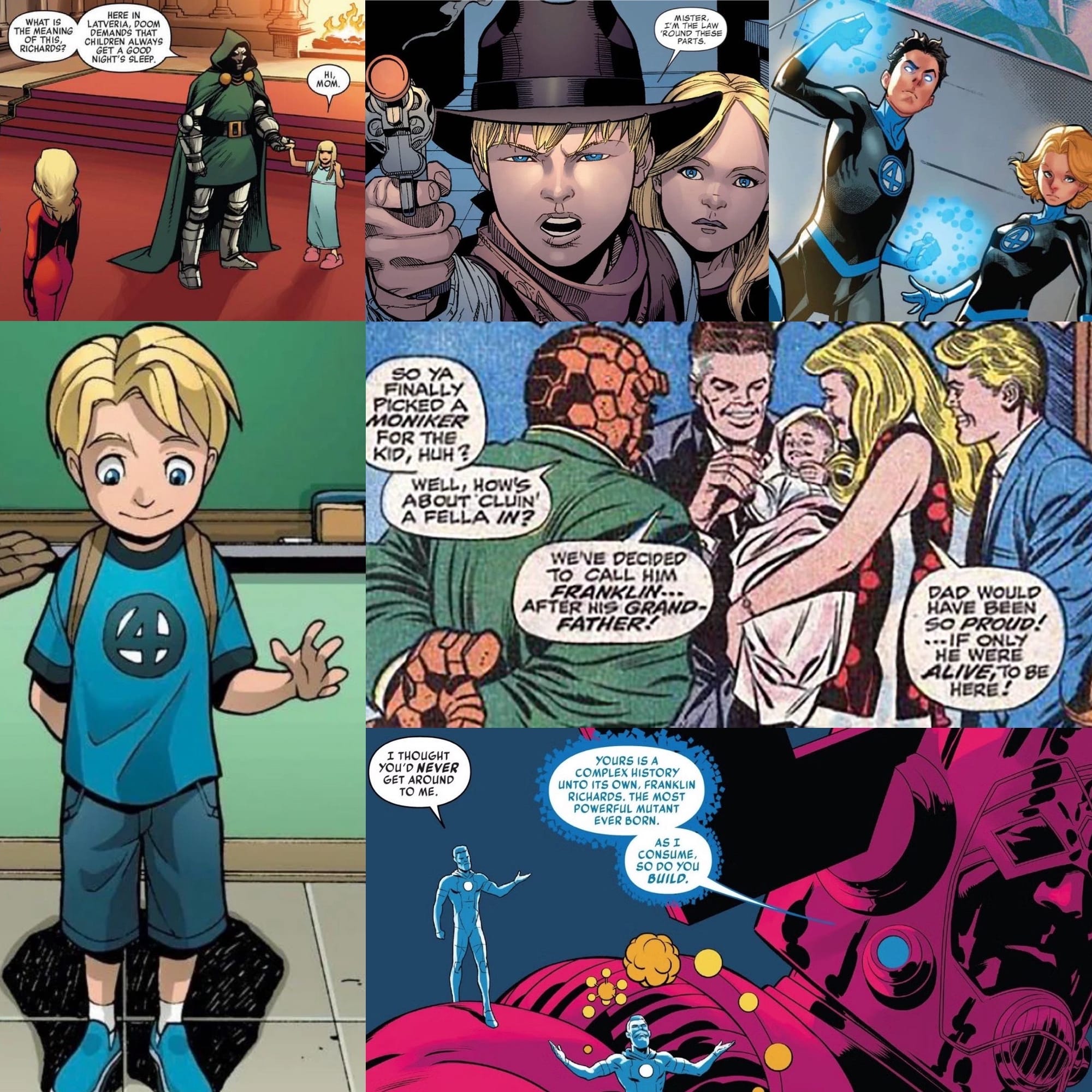
Although he didn’t receive a name until nearly two years later, Franklin Richards first appeared in Fantastic Four Annual #6 in November 1968. Created by Stan Lee and Jack Kirby as a somewhat natural result of Reed Richards and Sue Storm being married, Franklin’s life has been defined by the fact that, due to his parents’ skewed genetics, he was born with incredible power. Able to manipulate reality with ease, Franklin is the most powerful mutant in the Marvel Universe. As a baby and a young child, he was almost constantly in danger too, due to the many bad guys who wanted to use his power for their own nefarious purposes.
Honestly, it’s fair to say that Franklin Richards is ridiculously over-powered, and as a result, he's often somewhat of a narrative burden because of it. He can literally do anything, and with very little effort, so as a result, too often, a lot of work has to be put into creating a reason for why he doesn’t just wiggle his nose or whatever and fix everything. Much like the TV show Heroes, Franklin Richards is the kind of character who is best used as a lesson to modern day creators as to why, generally speaking, less power is better.
That’s why I’ve included Valeria von Doom/Valeria Richards in this introduction to sort of highlight this idea, even though she doesn’t appear in the film. Well that, and the fact that she probably will appear in a later movie. Franklin’s baby sister, first appearing in Fantastic Four (vol. 3) issue #50 in February 2002), and created by Chris Claremont and Salvador Larroca, Valeria has no real powers, other than her incredible intellect, which is why, despite her ridiculously convoluted, very typically hair-brained and nonsensical comic book origin, she’s more interesting than her brother Franklin. That's not the only reason, of course, the other is her hilarious relationship with her “uncle” Doom.
Anyway, Franklin is a bit of a McGuffin in this film, but that’s basically the role that he usually plays in the comics, so what are you gonna do?
The Baxter Building
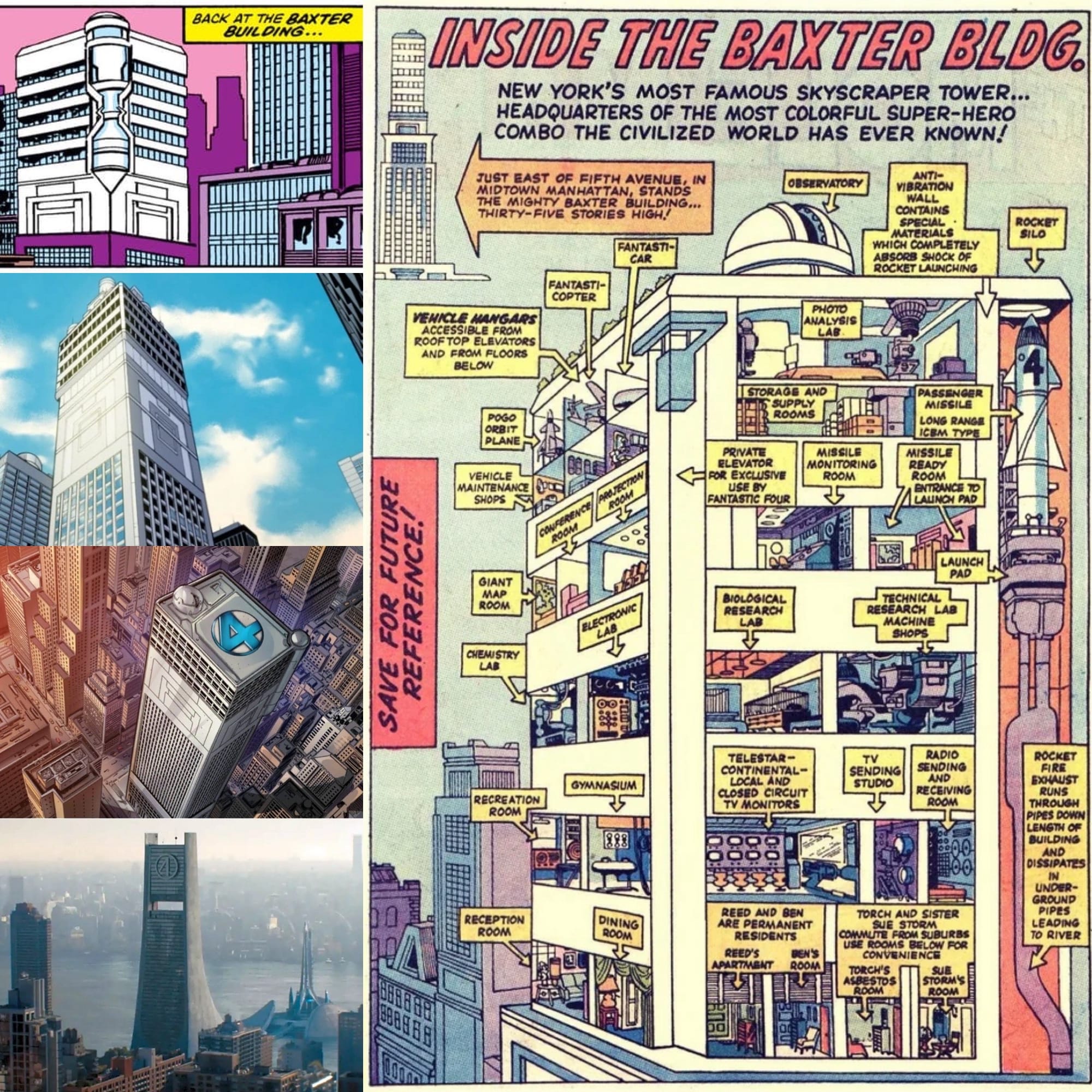
A 35-story office building located at the corner of 42nd Street and Madison Avenue in Midtown Manhattan in New York City, created by Stan Lee and Jack Kirby, and first appearing in Fantastic Four #3 in March of 1962. The five upper floors of the Baxter Building act as the home and headquarters of the Fantastic Four.
This obviously means that everyone else with office space in the Baxter Building fucking hates the Fantastic Four. How would you like to go to work some random Tuesday and find yourself suddenly launched into space by a foreign dictator, or maybe having to fight off a bunch of weird bugs from the Negative Zone during your lunch break, or maybe just coming to work one day and discovering that your cubicle was somehow covered in cosmically-irradiated gorilla poop over the weekend?
This was a running gag for years in the title, as the landlord, Walter Collins, who was initially eager to rent to a superhero team, quickly begins to regret it, as after the FF moves in, the building almost immediately becomes a constant target for supervillain attacks. Eventually, Reed Richards has to buy the entire building in order to avoid being evicted.
H.E.R.B.I.E.
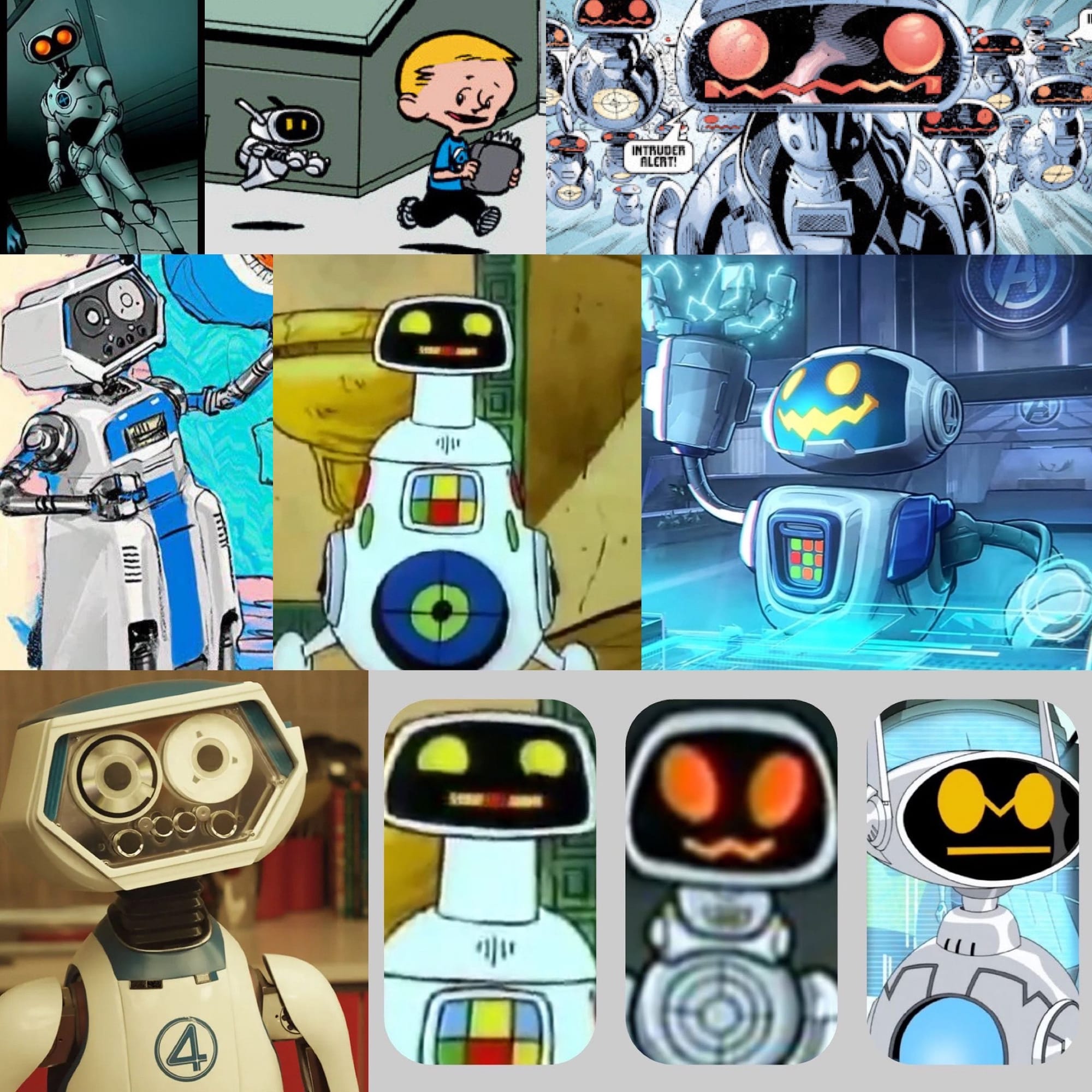
H.E.R.B.I.E. is the Fantastic Four’s helper robot, housekeeper, and nanny. He beeps and he boops and he trundles about.
Contrary to the popular urban legend, H.E.R.B.I.E., or Humanoid Experimental Robot, B-Type, Integrated Electronics, or sometimes, Highly Engineered Robot Built for Inter-dimensional Exploration, which first appeared in the Fantastic Four animated series in 1978, H.E.R.B.I.E. was not created out of a fear that the Human Torch character might encourage children to light themselves on fire.
The truth is, due to the Human Torch having been optioned for a film that never happened, and the fact that the show need a fourth member for the team, Stan Lee pitched the idea for a cute robot sidekick and artist Jack Kirby designed it.
H.E.R.B.I.E. was also Kirby's last work for Marvel, so put some respect on his name, okay?
The Silver Surfer - Shalla-Bal and Norrin Radd
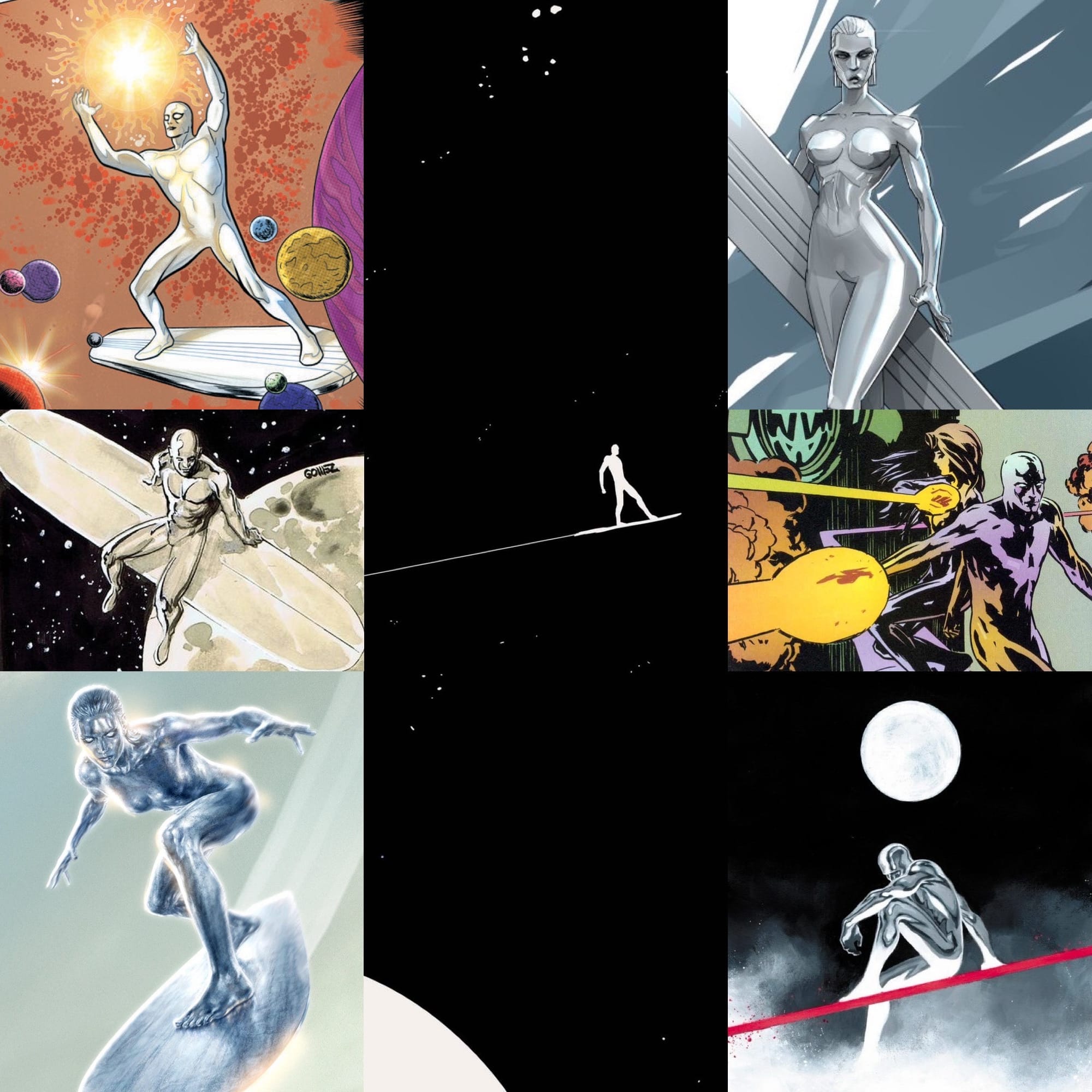
Created by Jack Kirby, and first appearing in Fantastic Four #48 in 1966, the Silver Surfer is a humanoid alien with metallic skin who can travel through space faster than light with the aid of his seemingly at least partially sentient surfboard.
Norrin Radd was a young astronomer on the planet Zenn-La who saved his world from the World-Eater, Galactus, by agreeing to serve as Galactus’ herald. Galactus then imbued Norrin Radd with a portion of his Power Cosmic, which gave him his silver-coated body and his surfboard, because apparently Galactus likes a little flair and alliteration with his outside-of-the-box solutions to problems. He then tasked Norrin Radd to surf the cosmos, searching for suitable (read: full of people with active societies) planets for Galactus to consume.
In an alternate continuity, Shalla-Bal, who was not only Norrin Radd’s lover, but also the empress of Zenn-La, is shown to have joined him as a second Silver Surfer, and both of them served as the twin heralds of the second Galactus, who was a grown-up Franklin Richards. Since this movie is set in an alternate universe from the main continuity of the MCU, the film decided to use Shalla-Bal as the Silver Surfer, instead of Norrin Radd, which upset a bunch of dumb misogynistic nerds, so that’s great.
But once again, I am disappointed that Julia Garner decided to not use her accent from the TV show Ozarks for the character of Shalla-Bal.
Galactus
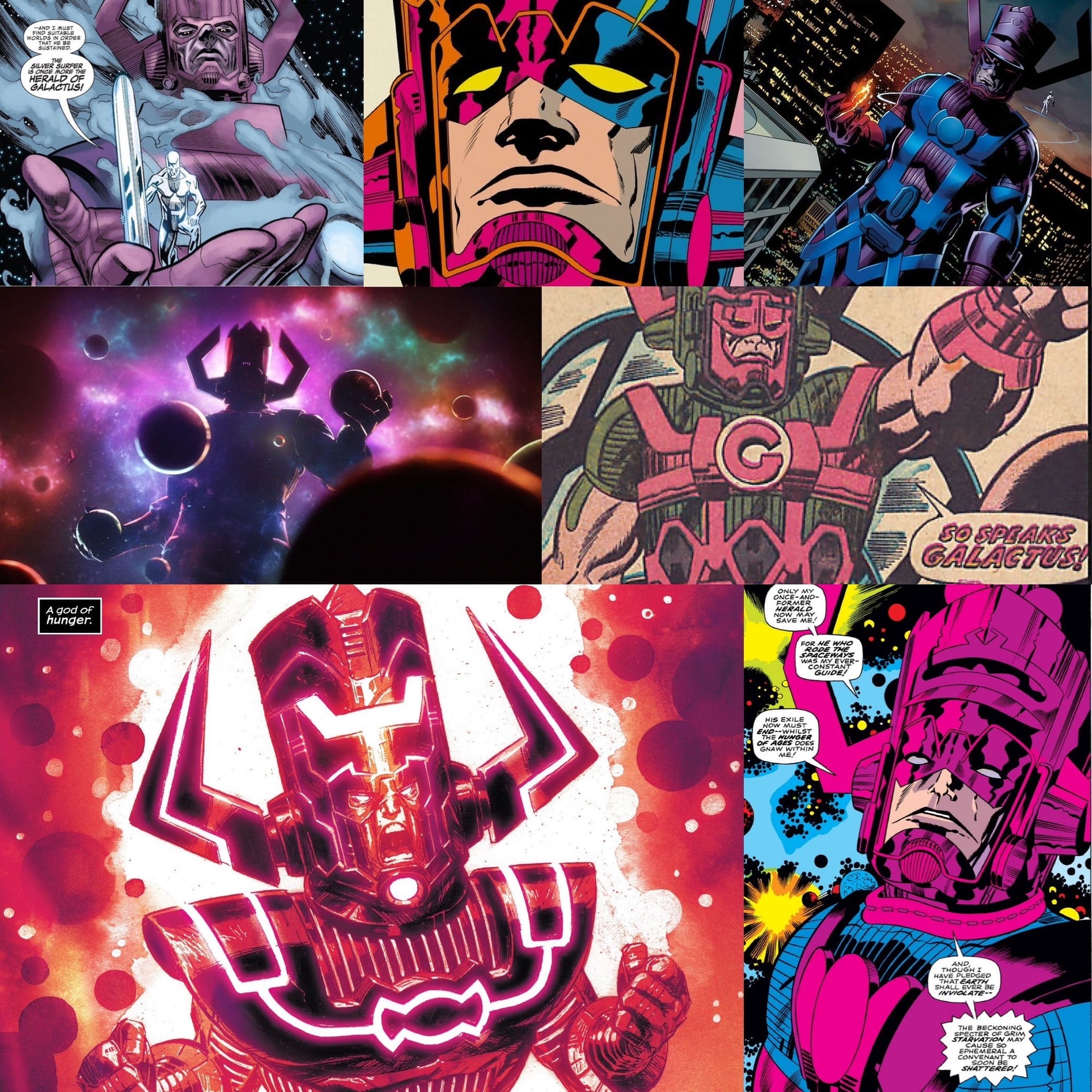
Created by Stan Lee and Jack Kirby, first appearing in Fantastic Four #48 in March of 1966, Galactus was once a mortal man named Galan. A Taa-an from the planet Taa, a planet from the universe that existed prior to the current Marvel universe, when Galan's universe was coming to an end, he merged with something called the "Sentience of the Universe" and ended up becoming the cosmic entity known as Galactus.
This is how Galactus survived the end of his universe.
He emerged into this newborn universe as a god-like being whose function is to now roam the cosmos, consuming planets in order to sustain his life force. He is a cold and uncaring deity, who sees to his duty without regard for the billions and billions of beings who must perish in order for him to temporarily sate his hunger. Despite his horrifying, and on-going, legacy of genocide that stretches across the universe, Galactus is a vital piece in the great machine that is creation. Y'see, wventually, Galactus will devour every planet in the universe, and all life, and once he does this, he will explode, becoming a new big bang, which will create a new universe, and also, somehow, because of a process that there is no possible way to make seem like it makes sense, create a new Galactus too.
So basically, Galactus is like a Galactic Force of Nature, a Cosmic Forest Fire that could strike at any time, and from which, eventually new growth will emerge.
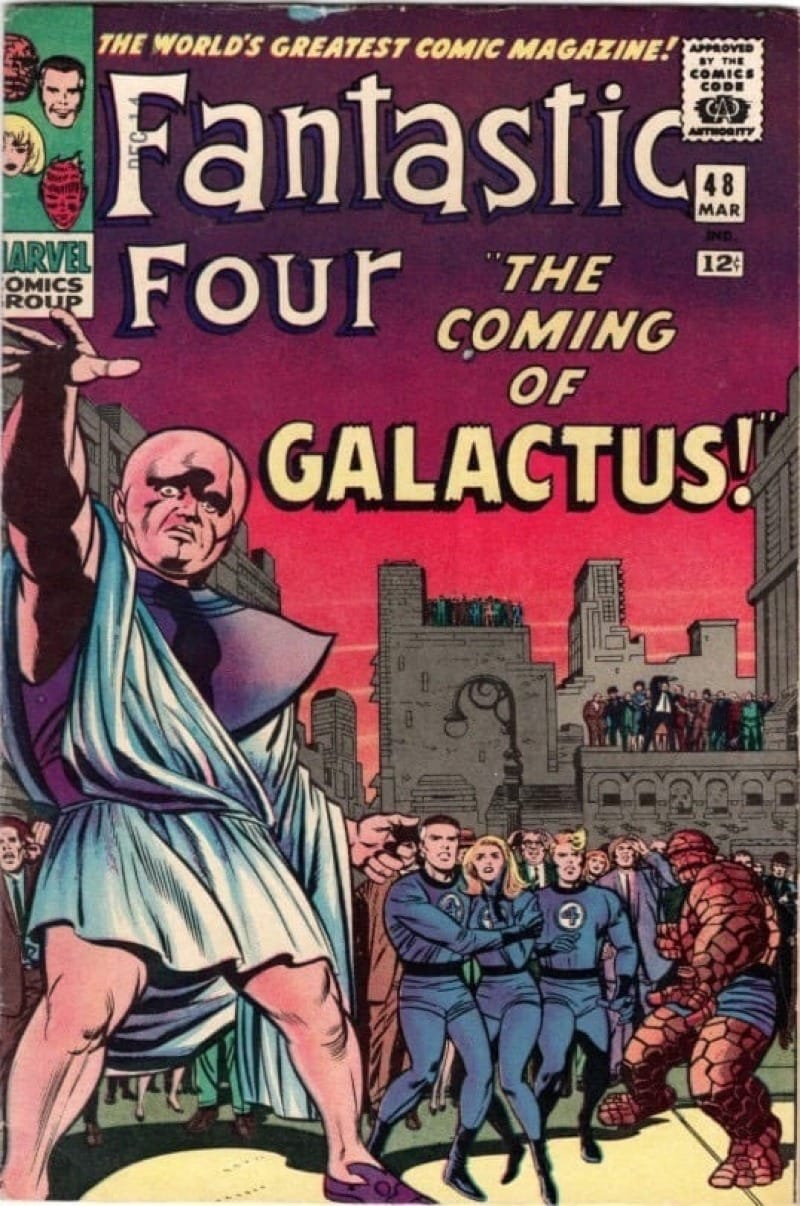
Good lord! Bring an umbrella, I guess...
The Mole Man
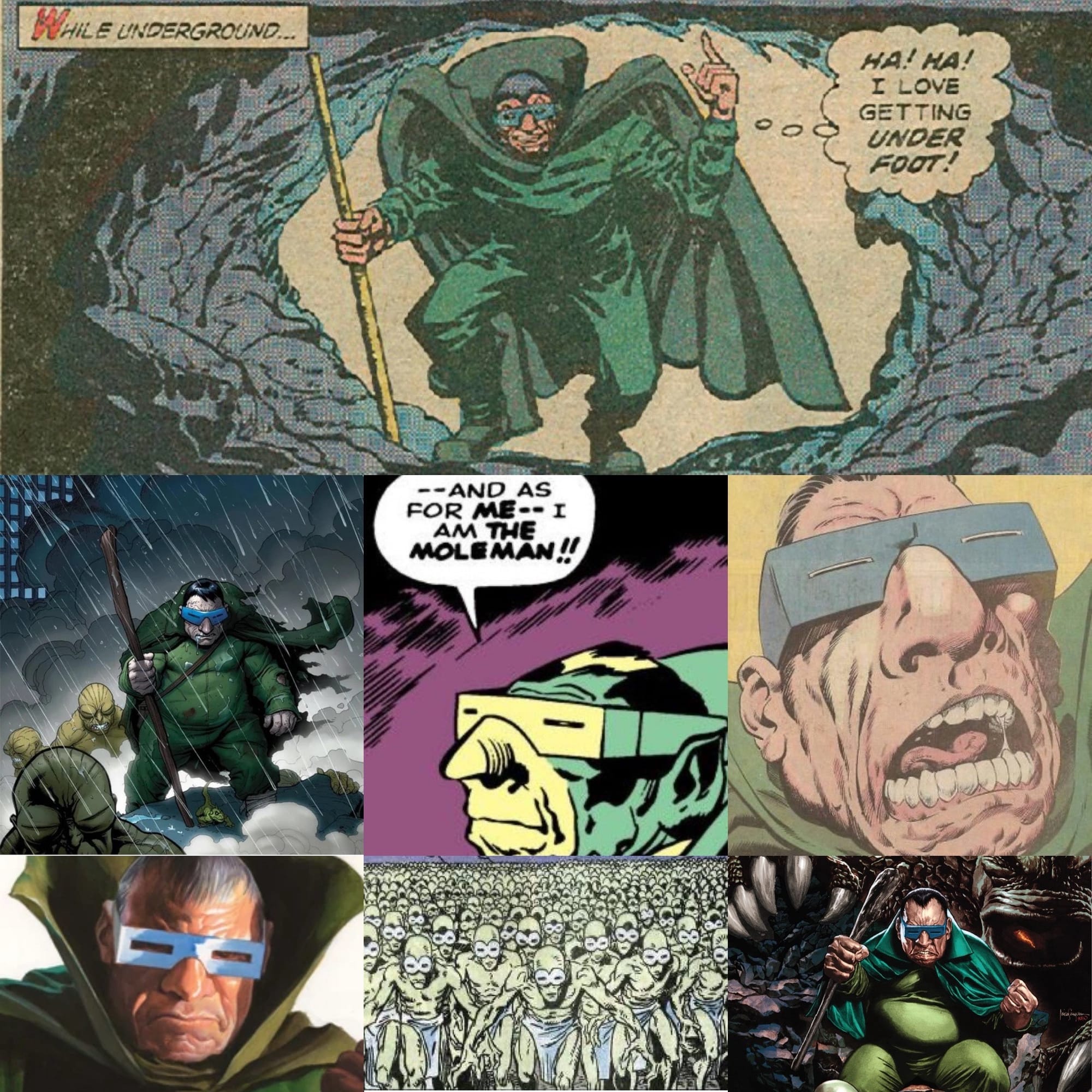
Created by artist Jack Kirby and writer Stan Lee, first appearing in The Fantastic Four #1 in November of 1961, Harvey Rupert Elder, aka The Mole Man, is the first supervillain the Fantastic Four ever faced. He’s basically a weird little guy in weird glasses, who is constantly trying to take over the surface of the Earth, usually by using his army of Moloids, a subterranean race of Deviants that he rules.
Harvey Elder was a nuclear engineer and explorer who had long been a bit of an outcast socially, mostly due to his abrasive personality and the fact that he’s ugly and short. Also, he was a big proponent of Hollow Earth theories, which are almost always super racist, so you know what that probably means...
But then in 1956, Harvey stumbled upon Monster Isle. While there, Harvey managed to fall in a hole and ended up in the underground realm of Subterranea, which he decided validated his theories. Unfortunately, his eyes were permanently damaged by the dazzling reflection of a bunch of diamonds. Now partially blind, Harvey decided to make lemonade out of his lemons, donned his weird glasses, dubbed himself the Mole Man, and decided to just live underground. While that certainly sounds like an extreme reaction to falling in a hole, in his defense, he does eventually become the ruler of Subterranea. Although, to be fair, I don’t know how stiff the competition was. Anyway, with his genius intellect, and his myriad of trick staves with their various hidden weapons, Harvey now uses ancient Deviant technology, as well as the monstrous creatures he has tamed in Subterranea, in order to take his vengeance on the surface world for rejecting him. So basically, he's a creepy little incel son of a bitch, who has made his shitty personality everyone else's problem.
That said, Paul Walter Hauser is great as the Mole Man. Absolutely perfect.
The Mad Thinker, The Puppet Master, Dragon Man, Diablo, The Wizard, and The Red Ghost and his Super Apes
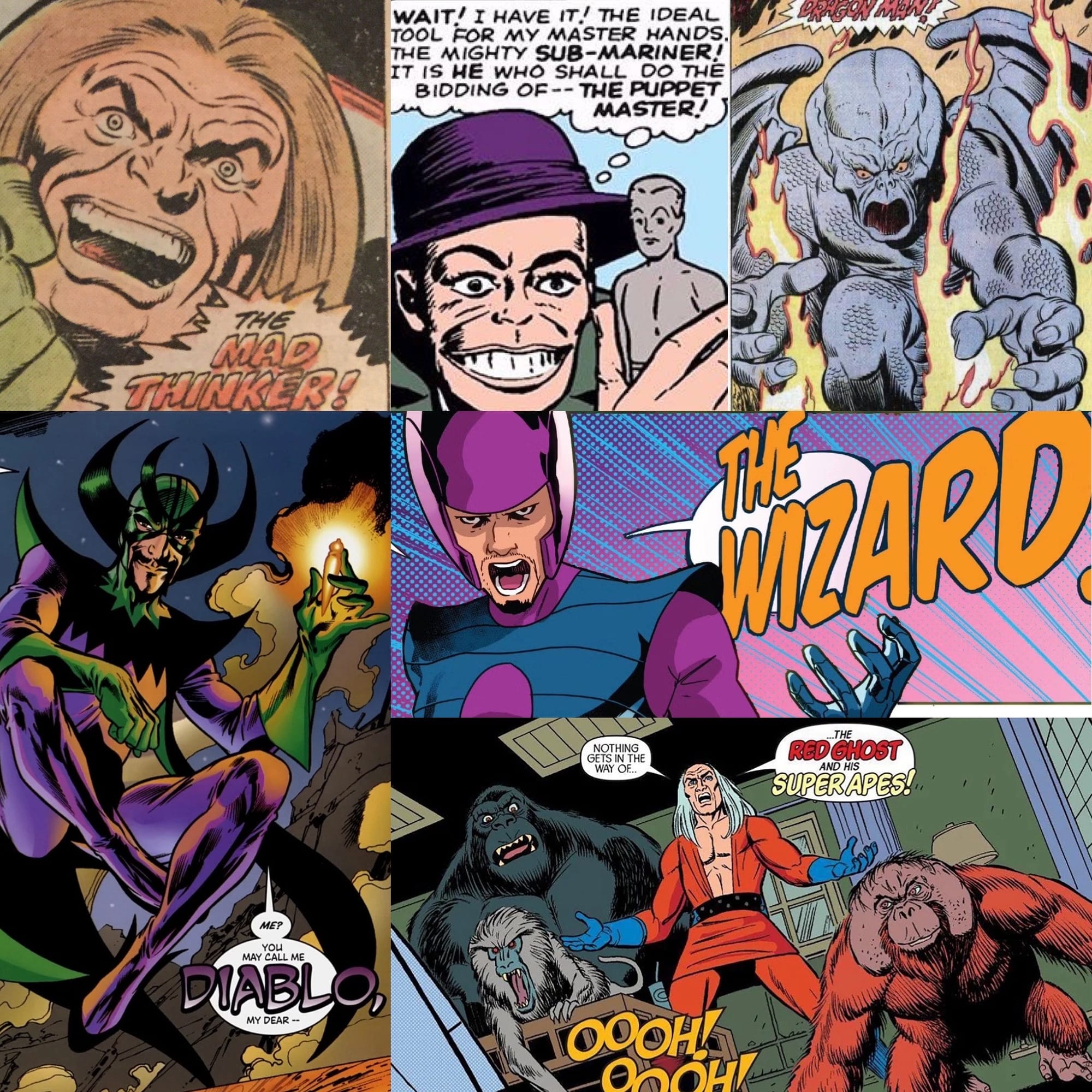
None of these guys actually appear in the film, but they are a plethora of classic Fantastic Four villains, and they do get mentioned, so...
- Created by Stan Lee and Jack Kirby, and first appearing in Fantastic Four #15 in June 1963, The Mad Thinker, or as he probably prefers to call himself, just The Thinker, or sometimes Julius, is an evil genius who specializes in building robots. He's not that impressive. One time, he was beaten by Willie Lumpkin, the Baxter Building’s long time mailman.
- Created by Stan Lee and Jack Kirby, and first appearing in Fantastic Four #8 in November 1963, the Puppet Master, aka Philip Masters, immigrated to America as a child from Transia, and grew up to be a friendless loser. After killing his business partner, Eric, and accidentally blinding Eric's daughter, Alicia, he marries Eric's widow, Marcia, and adopts Alicia. When Marcia dies, Philip takes his hobby of puppeteering, figures out a way to make puppets that can control the real people they're based on, and then uses the puppets to make that person commit crimes, because... I really have no idea why. Why not, I guess. Anyway, in the comics, Alicia was not only instrumental in getting the Silver Surfer to betray Galactus, she eventually married the Thing. She's blind, y'see, so she didn't have to look upon his hideous rock visage, because her lack of sight allowed her to see the man beneath. Also, just as a tangent, in alternate timelines, Alicia, a blind human woman, and the Thing, a rock monster, have had children, as in... multiple kids. This brings up the question of the Thing's penis. Personally, I assume it's like a dog's, but in a rocky sheathe. Thoughts?
- Created by Stan Lee and Jack Kirby, and first appearing in Fantastic Four #35 in November 1964, Dragon Man is a giant gargoyle/dragon android, with a giant head, that only ever wears a pair of little blue underwear, which means that this giant Dragon-looking android was built with some kind of sex organ. His creator was Professor Gregson Gilbert of Empire State University, who apparently did it just to see if he could, but I think the fact that he built Dragon Man with some kind of sex organ probably gives us a hint as to the real reason why. Gregson hoped to find a way to bring it to life (of course, he did), but was unable to do so until the alchemist Diablo arrived and brought it to life under his control. Too bad for Gregson, Diablo used Dragon Man to commit crimes and fight people like the Fantastic Four, instead of just for some weird sex. Eventually, Dragon Man gained his freedom. At first, Dragon Man is a kind of Frankenstein’s Monster, but after being destroyed and rebuilt several times, he was upgraded by Valeria Richards. He then joined with Valeria, and the other young geniuses who make up the Future Foundation, and now, in addition to wearing tiny blue underwear, he also wears tiny glasses, because he’s smart.
- Created by Stan Lee and Jack Kirby, and first appearing in Fantastic Four #30 in September 1964, Diablo is Esteban Corazón De Ablo, a court alchemist in 9th century Saragossa. Making a deal with Mephisto, Marvel comics’ Devil, Diablo trades his soul for a much longer life, in order to find the secret of immortality. Eventually, some villagers storm his castle and bury him alive. Over a hundred years later, when the Fantastic Four visit Transylvania on vacation… which, I mean, come on, man… Diablo convinces the Thing to free him by playing off of the Thing’s feelings of self-loathing over his appearance. This turns out to be a ruse, and Diablo has plagued the FF off and on ever since.
- Created by Stan Lee, Larry Lieber, and Jack Kirby, and first appearing in Strange Tales #102 in November 1962, The Wizard, occasionally known as The Wingless Wizard, Bentley Wittman was born a genius, became a child prodigy and chess champion, and when he grew up, became a successful inventor. Like all Tech Bros, Bentley is a dipshit. He legally changed his name to the Wizard and started using his inventions as a stage magician and escape artist. Perhaps inevitably, because he’s a Tech Bro dipshit, he eventually became a supervillain. At one point, he was part of a supervillain group called The Frightful Four that included him, the Spider-man enemy known as The Sandman, a supervillain with the name Paste Pot Pete, who shoots hot glue at people, and the amnesiac Inhuman superhero, Medusa, who fights people with her super super long and prehensile hair, which is super gross, because you know her hair has like, been dragged through puddles and shit. And in NYC too? Maybe even subway water, and that's super gross.
- Finally, created by Stan Lee, and Jack Kirby, and first appearing in Fantastic Four #13 in April 1963, the Red Ghost and his Super-Apes are Ivan Kragoff and Mikhlo, Igor, and Peotr. Born in Leningrad, Ivan Kragoff trained Mikhlo the gorilla, Igor the baboon, and Peotr the orangutan to obey him, and then they all launched into space in a direct attempt to replicate the accident that created the Fantastic Four. And it worked. Kragoff gained the ability to become intangible and invisible, Mikhlo became superhumanly strong, Igor gained the ability to shapeshift, and Peotr gained the ability to attract and repulse objects. There was originally supposed to be a scene with the Red Ghost and the Super Apes in the movie, with John Malkovich as Ivan Kragoff, but the scene was cut, except for a brief skirmish between Reed Richards and Peotr the orangutan. This is super disappointing, because the Red Ghost and his Super Apes are criminally underused, wonderfully ridiculous supervaillan concept. Fingers crossed for next time, especially because I assume Malkovitch will do the same Russian accent that he used in Rounders.

Dr. Doom and Latveria
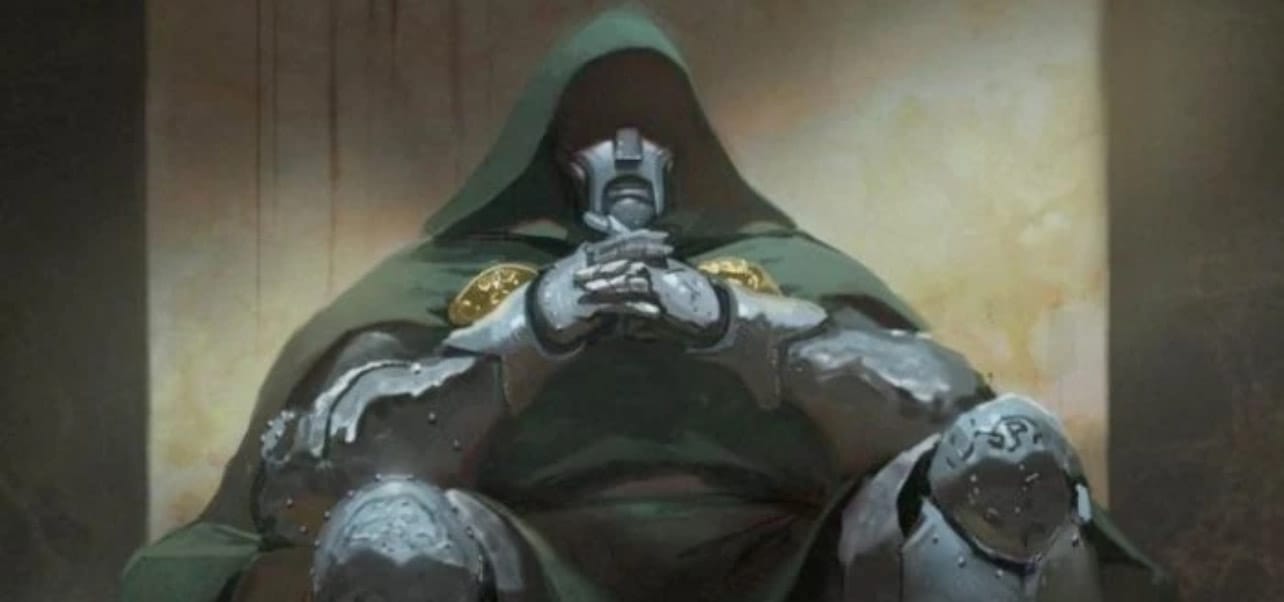
Finally, there’s Dr. Doom, the villain of the Fantastic Four.
Created by Stan Lee and Jack Kirby, and first appearing in The Fantastic Four #5 in April 1962, Victor Werner von Doom, or simply… Doom, is considered to be one of the smartest and most dangerous people to ever exist in the Marvel Universe. The monarch of the European country of Latveria, Doom uses his mastery of both super science and black magic to accomplish his goal of bringing the entire world under his control, and to also prove his intellectual superiority over Reed Richards, his old college rival.
When they were enrolled at State University in New York, Reed Richards spotted an error in Doom's equations, but when Reed Richards attempted to correct the error, an angry Doom rebuffed him. Doom’s experiment exploded in his face, and in his shame, Doom withdrew from State.
Doom seemingly always wears a magically-forged, high-tech suit of armor, and a hooded cloak, all to conceal the small scar on his face that he got in that explosion. To Doom, that scar is a constant reminder of how Doom was once bested.
Doom has held a grudge against Reed Richards ever since.
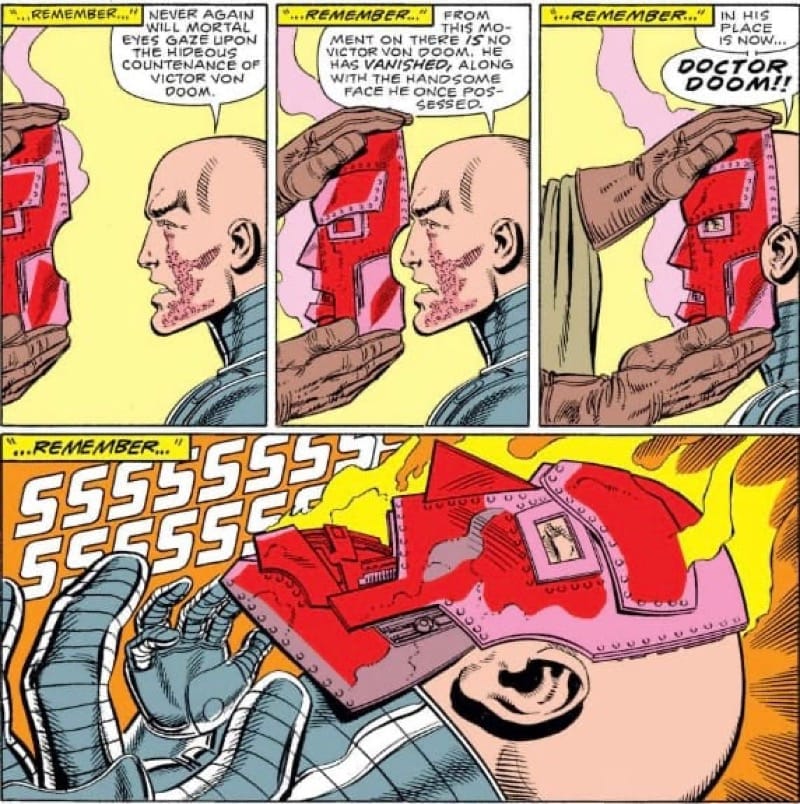
Why did he put that iron mask on his face when it was still hot?
Because fuck you, that's why! No one tells Doom what to do! Doom clearly meant to do it on purpose! And now, bring Doom the neosporin! And some ice! Just put it in one of Doom's handtowels! Yes, Doom's good handtowels are fine! Doom knows what was said earlier about not touching them, did Doom himself not give that command? Listen now to the words of Doom! Doom commands you to move faster! Doom's neosporin is on the second shelf of the medicine cabinet, you fool!
Doom also speaks of himself in the first person.

“Come to Latveria! So commands Doom! Enjoy Octoberfest, bow before Doom’s superior party-planning skills! Or Doom will destroy you!”
So, as I'm sure you're probably aware by now, the MCU is currently all about the Multiverse. Previously, it was all about Thanos and his quest to possess all of the Infinity Stones, but now it's the Multiverse, and presumably Dr. Doom's quest to rule it. Or... maybe it's about the collapse of the Multiverse, and the scramble to survive the end of everything. I don't know.
I assume we'll see eventually, unless of course the second Civil War kicks off here in the real world, an event that, no matter what happens here, is definitely going to happen somewhere in the Multiverse, just fyi, because that's exactly what the Multiverse is... endless alternate possible realities.
Anyway, the idea is that there are endless variations of different versions of the universe, all of which exist at the same time. Together, this wide and varied spectrum of alternate realities comprise everything that exists: all of space, time, matter, energy, information, and all the physical laws and constants that describe them. In a nutshell, the Multiverse is everything that is, that was, and that might have been, every decision that was made and not made, no matter how big or how small, that universe exists somewhere ad infinitum.
People currently like to complain about all of the Multiverse stuff apearing in the genre at the moment, and my Nerd Hot-Take–deliberately intended to cast all the Haters as objectively bad people–is this: I think the reason that people are complaining about "The Multiverse" concept in Comic Book/Sci-fi/fantasy stories is because they are all really uncomfortable with the idea that their decisions, their choices, all matter, that the things they do all have direct consequences. Because if this is true, then that makes their own personal responsibility both to society, and the world at large, something that is impossible for them to ignore, and they really don't like that shit, as these assholes would prefer to live their lives only ever thinking of themselves and satisfying their own wants, because they're generally selfish and entitled fucks.
But I digress again...
Anyway, up til now, the MCU movies (except for some of Doctor Strange and the Multiverse of Madness, and also an End Credits scene in The Marvels, and the three seasons of What if, of course) have taken place on Earth-199999. Some people claim the MCU all takes place on Earth-616, but they incorrect. 616 is the main continuity stories of Marvel Comics, which is much different from the MCU, so the MCU is Earth-199999.
This movie takes place on Earth-828, which is a whole different reality.
The Movie
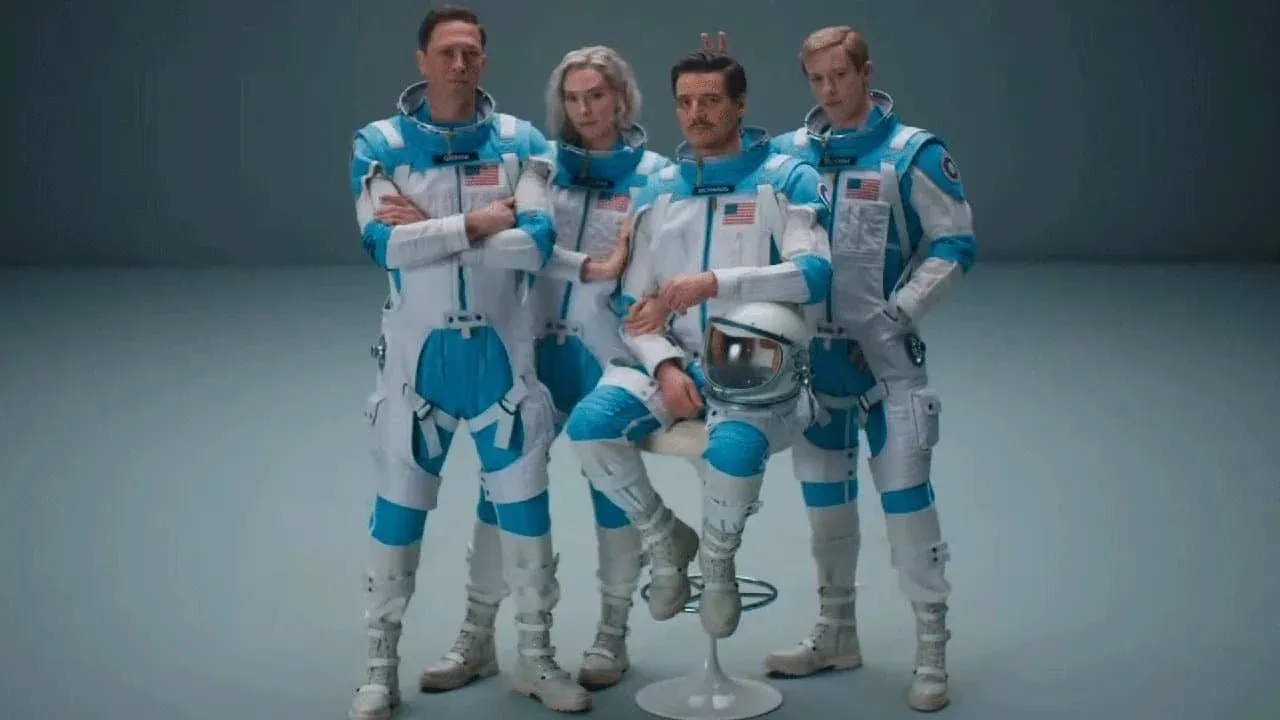
It's 1964, and the world is celebrating the fourth anniversary of the world famous astronauts turned celebrities and superhero protectors, The Fantastic Four. Reed Richards, Sue Storm, Ben Grimm, and Johnny Storm gained superhuman abilities from an accidental exposure to cosmic rays during a space mission. Reed Richards is now known as Mr. Fantastic, whose body can stretch. Sue Storm is now known as The Invisible Woman, as she can both turn invisible and create force fields. Ben Grimm is covered in rock and is superstrong. And Johnny Storm is the Human Torch, he controls fire and can fly. But while these abilities are certainly fantastic, they are also afflictions, and Reed still feels guilty that his miscalculations caused such genetic damage on his loved ones.
But despite that issue, the Fantastic Four has strived to make the world a better place, not only by fighting supervillains, but through Reed's incredible inventions and Sue's diplomacy via the Future Foundation, which has led to demilitarization and peace for much of the world. Throughout all of this, the FF tries to remain as much like a family as they can, all living in the baxter Building, along with their helper robot H.E.R.B.I.E., and having a regular family dinners.
But things begin to change when Reed and Sue reveal that they're expecting.
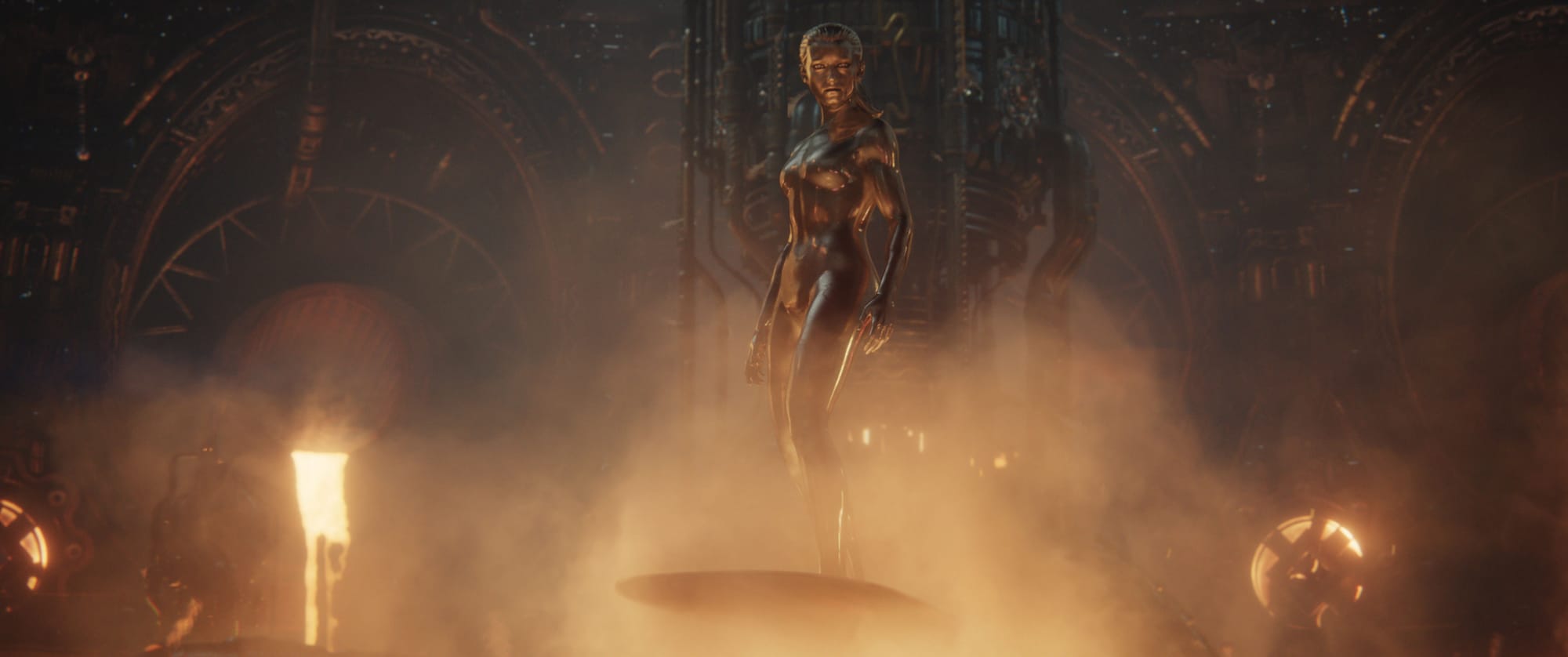
Months pass, and then one day a strange being arrives. The Herald known as the Silver Surfer descends from the Heavens, and announces that the Earth has been marked for destruction by an ancient cosmic entity known as Galactus.
The Fantastic Four decide to take the fight to Galactus.
Tracking the Silver Surfer's energy travel across the galaxy, they arrive at a new planet just as it is destroyed by Galactus's ship. They are captured and brought to Galactus, a ginat god-like being, who tells them that he has an insatiable hunger, and it has driven him to consume planets for unknown eons. He uses the Silver Surfer to locate suitable planets for him, and that Earth is next. But then Galactus tells them Reed and Sue's unborn child has an immense cosmic power, the kind of power that could take Galactus' place, thus freeing him from the neverending torture of his hunger. He offers to spare Earth in exchange for the child, and uses his power to force Sue to go into labor. They FF fight back and escape, the Silver Surfer in pursuit. Unable to shake the Silver Surfer, they use the gravity of a collapsing neutron star, which destroys the faster-than-light drive on their ship, but the Surfer is caught within it, while the FF is propelled home.
Along the way, Sue gives birth to a boy, Franklin.
It takes a month for them to return to Earth, but when Reed recounts the encounter during a press conference, explaining how they refused to sacrifice one child over the billions of other people on Earth, the public turns on them. While Johnny tries to decipher the Silver Surfer's native language using some similarly-sounding deep space transmissions the FF intercepted, the public grows angrier. As Galactus draws near, Sue faces the mob, reassures them, and wins them back.
“I will not sacrifice my child for this world. But I will not sacrifice this world for my child.”
Reed devises a plan involving large teleportation gates all across Earth, with the idea of transporting the entire planet to another solar system, which would ensure that Galactus cannot find them. Through the Future Foundation, Sue organizes the world's nations to build the gates and conserve the energy needed to use them. But right as the gates are about to be activated, the Silver Surfer suddenly returns and starts destroying them, one by one. Johnny stops her before she destroys the last one, which was built in Times Square, by playing the deep space messages they has intercepted, which turn out to be from her home planet. He has deciphered them, and knows who she is, that her name is Shalla-Bal, and that she choose to become the Herald of Galactus in order to save her own planet of Zenn-La. Upon hearing her home again, as well as transmissions from planets she helped destroy, pleading for help, Shalla-Bal flees, despondent and wracked with guilt.
With no other option, and Galactus' ship parked overhead, the Fantastic Four have one last desperate plan... to use Franklin as bait, draw Galactus from his ship, and use the last bridge to teleport him to the far side of the universe.
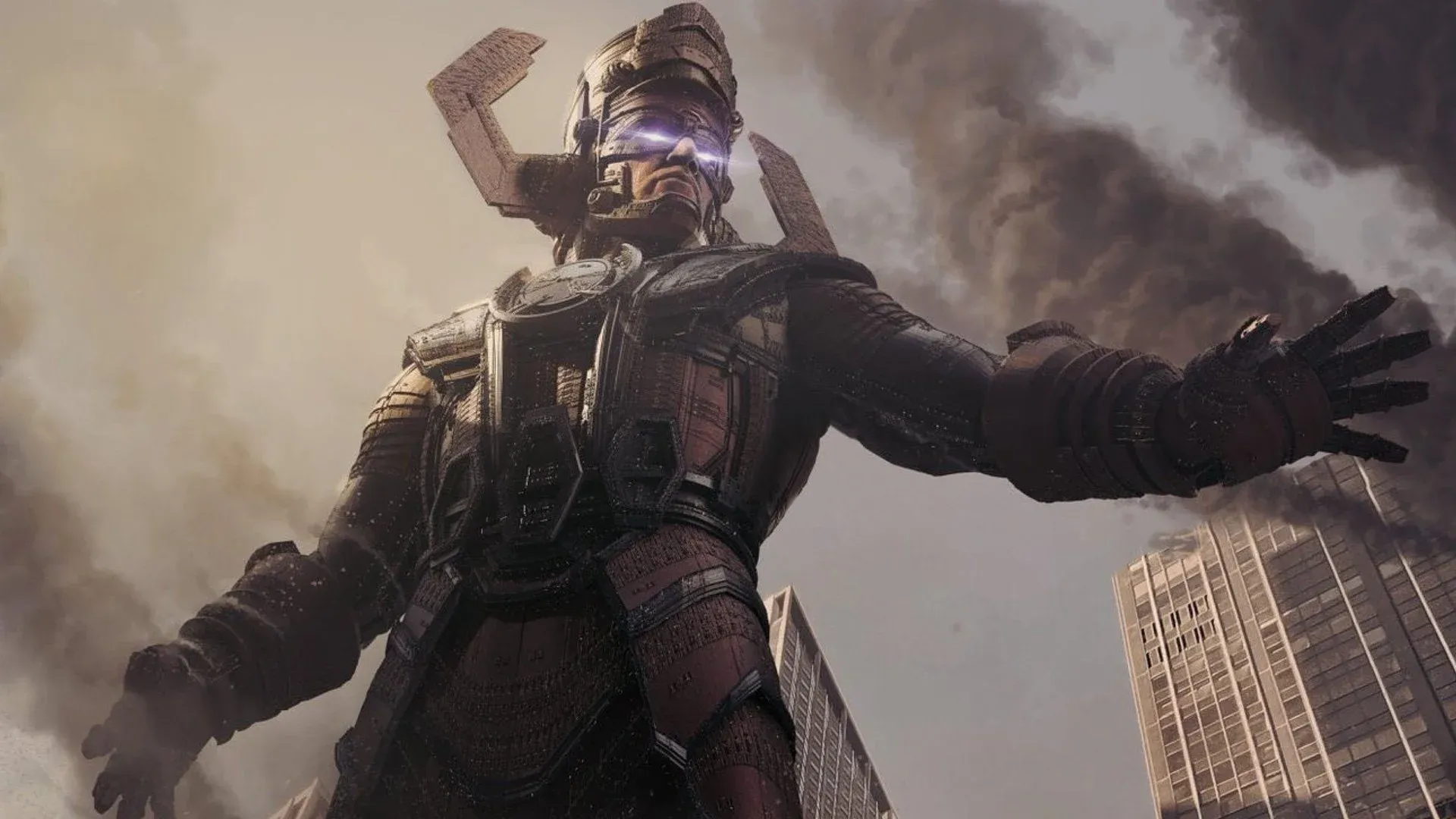
Once the plan is decided... it's clobberin' time.
So, let me just say it straight… I loved this movie. It's in my MCU Top Ten.
This is a fun, smart, and all-around entertaining film that not looks great, but wows with its action scenes. It has a fantastic cast with great chemistry, and it's an absolute love letter to the Lee/Kirby era of retro-futuristic 1960s Marvel, a world where its faster-than-light rockets use computers with magnetic-tape data storage. I loved that. I also loved how this film includes so many unintrusive nods to the characters’ creators. Like how their ship is called The Excelsior, a nod to Stan Lee’s famous catchphrase. Well, one of them, at least. And also, how this takes place in Universe 828, which is a reference to Jack Kirby’s birthday 8/28/17. Just a few days ago would’ve been his 108th birthday, in fact.
That these nods are so small and unintrusive is indicative of what the narrative choices in the rest of the film are generally like too. Smart. Well-executed. Done with love. Like how the film begins in the bathroom and the kitchen of the Baxter building. This highlights how the family aspect, the easy love, and easy familiarity of the characters, is so important. The movie gets this, and does such a great job of conveying it. There’s a sweetness to the cast, and levity too, as well as stress, and disagreements, but that’s how it’s supposed to be. The Fantastic Four aren't super-soldiers, or weary warriors, or outlaws looking for redemption, they’re a family, the “First Family” of Marvel Comics, and even when the threat of Galactus looms over them, this is apparent.
And the balance between the “big” problems and the “little” problems are exactly the way it should be too. Whether it’s Johnny Storm wanting to prove himself as part of the team, while also trying to connect with the Silver Surfer. Or Sue Storm weighing both her child’s future in their home, as well as his place in the universe. Or Ben Grimm struggling with the weight of his celebrity, of being so recognizable, against the isolation and loneliness that he feels. Or Reed Richards, wracked with guilt over the mistakes he has made in the past, that when he is faced with the fate of not only his child and his family, but the entire world hanging on the choices he makes, he doubts himself. This not only allows the characters to shine, but their vulnerability makes their heroism all the more meaningful. And on top of that, the film does a great job of balancing the humor, especially with the final moment of the film being that familiar struggle of trying to put a baby seat in the car.
Is the plot pretty standard? Sure. Does it feel rushed at times? Yes. Does it land every beat perfectly? No. Do I feel like the film had room for another 20 minutes or so of breathing room? Yes. Although, to be fair, that just may be me wanting to luxuriate more in its fantastic goodness. Regardless of that, it's still a great time. It's still a fun story. And it looks fantastic...
The film ends with a quote from Jack “the King” Kirby…
“If you look at my characters, you will find me. No matter what kind of character you create or assume, a little of yourself must remain there.”
That’s why he’s The King.
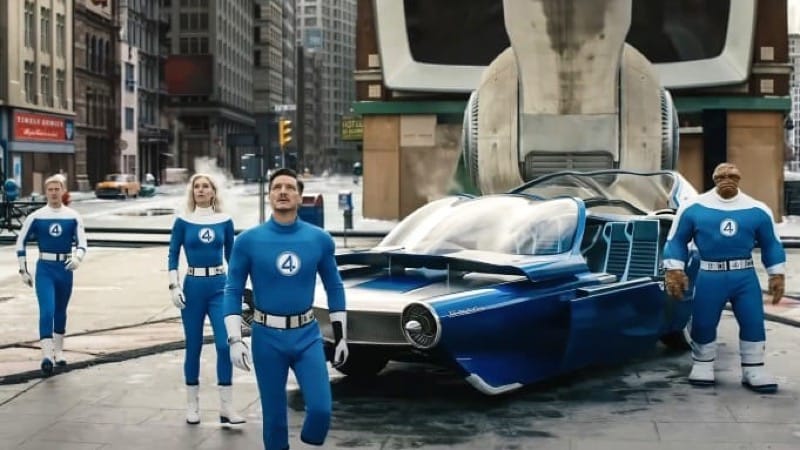
Anyway, this is a Marvel movie. There’s been 37 of them in the last seventeen years. And while, like Thunderbolts, The Fantastic Four: First Steps is definitely one of the better examples in a while, you still know what to expect here, and that's pretty much what you get, and you either like that kind of stuff or you don't.
But me? I loved it.
